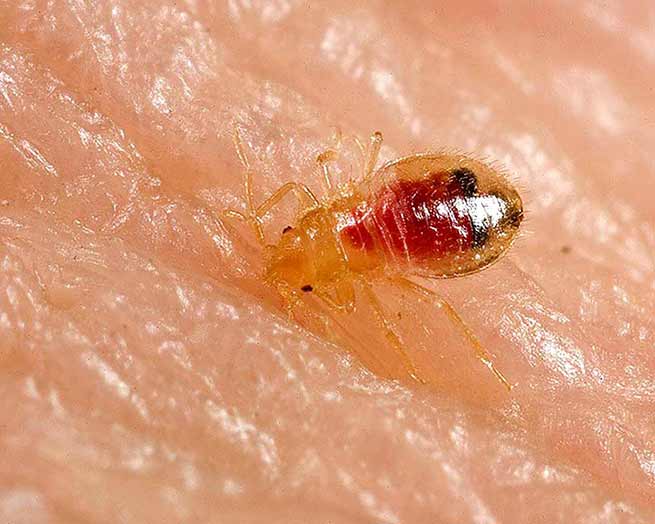Bed Bug Treatment Decoded: Your Roadmap to Removal
Bed Bug Treatment Decoded: Your Roadmap to Removal
Blog Article
Efficient Bed Insect Treatment Alternatives Supplied by Bug Control Professionals
These specialists provide an array of treatment choices customized to address the special obstacles positioned by these relentless pests. From warm therapies that pass through deep into furnishings and walls to chemical applications created to eliminate bed pests at all life phases, the toolbox of approaches readily available can be frustrating.
Warmth Therapy
Making use of warmth therapy is a highly effective approach for getting rid of bed insects in property and industrial settings. This method involves elevating the temperature of the infested location to levels that are deadly to bed bugs while being safe for human beings and pets. The procedure generally requires customized equipment and trained professionals to make sure appropriate execution.
Among the key benefits of warmth treatment is its ability to penetrate deep right into splits, gaps, and furnishings where bed pests may be hiding (bed bug treatment). Unlike some chemical therapies that bed insects may have developed resistance to, warmth therapy is a physical and mechanical approach that can effectively eliminate bed bugs at all life phases, including eggs
Moreover, heat therapy is a non-toxic solution, making it a recommended option for eco mindful people or those concerned concerning the use of chemicals in their living or functioning spaces. This approach also offers the benefit of quick therapy times, with lots of problems being settled in a solitary treatment session, minimizing disturbance to the passengers of the treated location.
Chemical Therapy
One common sort of insecticide used in chemical treatments is pyrethroids, which are artificial versions of pyrethrins, natural insecticides found in chrysanthemum blossoms. Pyrethroids are effective against bed bugs and have a quick knockdown effect, making them a preferred option for insect control therapies. Another team of insecticides, neonicotinoids, interfere with the bed bugs' nerves, causing paralysis and death.
Prior to administering chemical therapies, pest control professionals perform a complete examination to recognize the level of the invasion and identify one of the most ideal pesticides to make use of. Correct application strategies and safety precautions are important to make sure the efficiency of chemical therapies in removing bed pests.
Steam Therapy
Vapor treatment is a technique commonly utilized in the removal of bed insects as a result of its effectiveness in killing these insects and their eggs. This procedure entails making use of steam devices that create high temperatures, commonly over 120 ° F, to target bed insects hiding in various surface areas like mattresses, furniture, and rugs. The extreme warm produced by the vapor penetrates the small gaps where bed insects stay, effectively killing them on contact.
One of the key advantages of heavy steam therapy is its safe nature, making it a preferred choice for eco conscious individuals seeking pest control services (bed bug treatment). Furthermore, heavy steam treatment can be particularly helpful in situations where chemical treatments may not appropriate, such as in areas where using pesticides is restricted or when dealing with delicate things like books or electronic devices
When executed by qualified bug control specialists, heavy steam therapy can be a very effective approach for getting rid of bed insect problems. It is essential to note that while heavy steam therapy can be effective in killing bed insects and their eggs, multiple therapies may be necessary to entirely avoid and eliminate an infestation re-infestation.
Vacuuming
In the context of bed insect therapy, an added efficient technique to consider is vacuuming, which can aid remove bed insects and their eggs from different surface areas in a non-toxic manner. Vacuuming is specifically helpful for targeting bed bugs in hard-to-reach locations such as splits, crevices, and furniture where these parasites often conceal. When utilizing a vacuum cleaner for bed insect elimination, it is necessary to utilize a device with solid suction power and a high-efficiency particulate air (HEPA) filter to make sure that captured bed insects and their eggs are effectively entraped and contained within the vacuum cleaner. On a regular basis vacuuming plagued locations can dramatically decrease the bed insect populace, specifically when combined with various other treatment methods. It is necessary to keep in mind that vacuuming alone might not entirely eradicate a bed bug problem but can be an important part of a comprehensive integrated pest administration strategy. Consulting with insect control specialists for guidance on the appropriate vacuuming techniques and frequency can enhance the performance of this method in combating bed pests.
Monitoring and Follow-Up
To make certain the continued performance of bed insect treatment, persistent tracking look at these guys and timely follow-up are crucial parts of a comprehensive insect management technique. After initial treatment, routine surveillance is essential to discover any kind of indicators of bed bug activity. Bug control specialists employ numerous checking strategies such as visual assessments, interceptor traps, and bed bug smelling dogs to determine any type of renewal of bed bugs. By checking consistently, specialists can catch any brand-new infestations beforehand, protecting against a full-blown recurrence.
Follow-up brows through by bug control experts are essential to evaluate the therapy's success and attend to any kind of lingering concerns. These brows through allow professionals to review the efficiency of the initial treatment, make required modifications, and look at here now offer additional therapies if needed. Follow-up assessments also ensure that any type of remaining bed pests or eggs are eliminated, decreasing the risk of reinfestation. Additionally, pest control specialists can provide advice on precautionary steps to aid home owners prevent future bed insect problems. In general, persistent tracking and timely follow-up play a vital duty in keeping a bed bug-free setting.
Verdict
In final thought, reliable bed pest therapy choices used by pest control professionals include heat treatment, chemical therapy, steam treatment, vacuuming, follow-up, and tracking. It is crucial to consult with an expert parasite control solution to establish the best therapy strategy for your specific circumstance - bed bug treatment.

Report this page